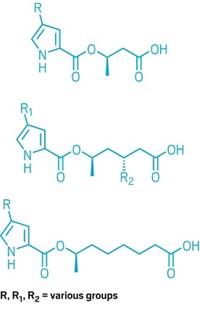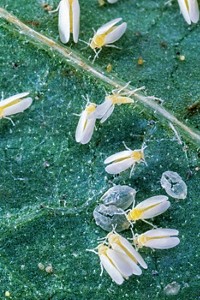Advertisement
Grab your lab coat. Let's get started
Welcome!
Welcome!
Create an account below to get 6 C&EN articles per month, receive newsletters and more - all free.
It seems this is your first time logging in online. Please enter the following information to continue.
As an ACS member you automatically get access to this site. All we need is few more details to create your reading experience.
Not you? Sign in with a different account.
Not you? Sign in with a different account.
ERROR 1
ERROR 1
ERROR 2
ERROR 2
ERROR 2
ERROR 2
ERROR 2
Password and Confirm password must match.
If you have an ACS member number, please enter it here so we can link this account to your membership. (optional)
ERROR 2
ACS values your privacy. By submitting your information, you are gaining access to C&EN and subscribing to our weekly newsletter. We use the information you provide to make your reading experience better, and we will never sell your data to third party members.
Environment
Fungi To The Rescue
Biopesticide derived from mold has promise as a greener method for eradicating insect pests
by Stephen K. Ritter
December 4, 2006
| A version of this story appeared in
Volume 84, Issue 49
When Paul E. Stamets, the proprietor of gourmet and medicinal mushroom provider Fungi Perfecti, Olympia, Wash., bought an old farmhouse in the mid-1980s, he quickly discovered a homeowner's nightmare: A wood-digesting fungus known as an artist's conk had invaded the home and was destroying the floor. The fungus and the softened wood are favorite foods of some insect pests, and Stamets soon found his slumping house under attack by carpenter ants that left tiny piles of sawdust all about.

But unlike the average homeowner, Stamets is a fungus expert. He took matters into his own hands. The end result was his discovery of a now-patented pesticide technology that takes advantage of chemical cues produced during one stage of the life cycle of the green mold fungus Metarhizium anisopliae to attract carpenter ants and other insect pests and infect them with the fungus, which later kills them. An additional benefit is that chemical cues produced by spores in a subsequent stage of the fungal life cycle help shoo ants and other insect pests away indefinitely.
The technology is being licensed through Mycopesticide LLC, a company Stamets created. It could have significant economic impact as an alternative to traditional chemical pesticides, while reducing harm to human health and the environment, he believes. For instance, only a teaspoonful of the fungus grown on a substrate such as rice and costing a few cents to produce is sufficient to treat a single home for years, Stamets says. In addition, M. anisopliae and the active compounds it generates don't appear to be harmful to humans, other mammals, fish, useful insects such as honeybees, or plants.
Stamets had heard about M. anisopliae and other mold fungi, called entomopathogenic fungi, that kill insects and use their carcasses to disseminate spores. The pesticide industry has been exploring the use of spores isolated from dead insects as natural insecticides for some time, but with limited success, he notes. One problem is that insects are sensitive to the spores and avoid them, and soldier insects guarding nests sense and intercept most spore-contaminated foragers to prevent them from entering and infecting the colony.
In search of a possible way to save his home, Stamets ordered a culture of M. anisopliae and began to experiment. Strains of the fungus produce chemical attractants in the mycelial state, the stage of the life cycle when a fuzzy mat ofmycelium, as shown protruding from a dead carpenter ant (bottom), making the mycelium an effective biopesticide.
The spores attach to insects and germinate, using enzymes known as chitinases to bore through the exoskeleton. Once inside the insect, the mycelium grows and produces a host of chemicals. These include destruxins, a class of hexadepsipeptides that compromise calcium ion channel function and are immunosuppressive, and cytochalasins, a class of compounds that affect cell mitosis. Other compounds, still being investigated, affect protozoans living in the insects' gut that are necessary to digest cellulose. In the end, the weakened insects die as the mycelium takes over.
The dead insects look mummified with the fuzzy mycelium, and they become a launching platform for more fungal spores. In the sexual form of the fungus, a tiny club-shaped Cordyceps mushroom grows from the insect carcass. The dead insects left in a decimated colony ward off subsequent insect invasions because the carcasses remain moldy with the repellent spores.
Stamets reasoned that if termites and ants could be attracted to the mycelium well before spores were produced, they would eat it and carry fragments of it back to their nests without being stopped by the guards. When the spores were eventually produced, they could fatally infect the colony.
He isolated a small amount of the mycelium from the culture he ordered. Through several subsequent generations of culturing just the mycelium, he was able to create strains of M. anisopliae that delay spore production for several weeks. He then grew some of the modified mycelium on rice and tested it by placing a small amount of the rice on a foraging path of the resident carpenter ants in his house.
"That night, about four hours later, my daughter spotted a swarm of ants on the mycelium-covered rice," Stamets recalls. "The ants became distribution vectors for the mycelium and promptly infected their nest. A week or two later, my old decomposing farmhouse was rid of carpenter ants." The house eventually had to be destroyed because of the previous damage, but Stamets saw no signs of carpenter ants or termites for four years after his pilot test.
Stamets initiated a series of research trials carried out by entomologists Roger E. Gold and Kimberly M. Engler of Texas A&M University (Sociobiology 2004, 44, 211). Lab and field experiments found that the M. anisopliae mycelium was a preferred food for many insects and more effective against Formosan termites, eastern subterranean termites, and fire ants than a common commercial chemical pesticide. The research also showed that highly diluted water-ethanol extracts of the mycelium can be used to attract insect pests.
The results of the Texas A&M research helped Stamets to patent his discovery. The current patents broadly cover using the mycelium of all species of Metarhizium and Beauveria fungi directly or a mycelium extract as an attractant for all social insects—a significant milestone because social insects (insects with a queen) encompass more than 200,000 species.
The technology is being promoted by technology brokerage firm Yet2.com, Needham, Mass., which is working with a half-dozen interested companies so far in the U.S. and other countries to evaluate potential products. Some of the early M. anisopliae products developed by others have already met with Environmental Protection Agency approval for pesticide uses, so products derived from Stamets' invention are expected to gain quick approval, according to Phillip B. Stern, chief executive officer of Yet2.com.
The M. anisopliae mycelium technology is "a platform for multiple applications," Stern says. One type of product would be the active mycelium itself, which could attract and kill insects. Another type of product would be the isolated "chemical actives" that could be extracted from growing mycelium or synthesized and then used to attract insects to a bait station to feed. A second component would be used to kill the insects.
The suite of chemical attractants produced by the mycelium has not yet been pinpointed, Stern adds. Research currently being carried out in conjunction with the Department of Agriculture's Agricultural Research Service is "showing strong promise, but it's in the early stages," he says.
Stamets' mycopesticide discovery could become an integral part of the lucrative pesticide market, which is estimated to be nearly $9 billion per year in the U.S., with biopesticides representing a 5% market share, Stern notes. The biopesticides sector is growing by approximately 15% per year, he says.
"Many insecticides and biocontrol agents are repellent to insects, and therefore the control is poor because the insects don't come in contact with the product," comments entomologist Pamela G. Marrone, who has pioneered commercial agricultural biofungicides and is CEO of Marrone Organic Innovations, Davis, Calif. "The significance of Stamets' work is that it can improve the efficiency and efficacy of fungal-based biopesticides and could improve chemical-biopesticide combinations." But many more field trials will be necessary to fully prove the technology for commercial use, she says.
There currently aren't any commercial biopesticides for termites, Marrone notes. The main technology uses chemical bait systems to attract termites and an insect growth regulator to kill them. "Although insect growth regulators are rather benign insecticides, many homeowners I talk to would like a nonchemical solution to termite control," Marrone adds. She thinks Stamets' mycopesticide could do the trick.






Join the conversation
Contact the reporter
Submit a Letter to the Editor for publication
Engage with us on Twitter